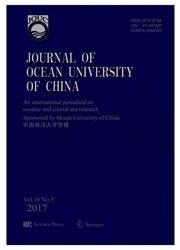

 中文摘要:
中文摘要:
Oil spill models can effectively simulate the trajectories and fate of oil slicks, which is an essential element in contingency planning and effective response strategies prepared for oil spill accidents. However, when applied to offshore areas such as the Bohai Sea, the trajectories and fate of oil slicks would be affected by time-varying factors in a regional scale, which are assumed to be constant in most of the present models. In fact, these factors in offshore regions show much more variation over time than in the deep sea, due to offshore bathymetric and climatic characteristics. In this paper, the challenge of parameterizing these offshore factors is tackled. The remote sensing data of the region are used to analyze the modification of wind-induced drift factors, and a well-suited solution is established in parameter correction mechanism for oil spill models. The novelty of the algorithm is the self-adaptive modification mechanism of the drift factors derived from the remote sensing data for the targeted sea region, in respect to empirical constants in the present models. Considering this situation, a new regional oil spill model(i4Oil Spill) for the Bohai Sea is developed, which can simulate oil transformation and fate processes by Eulerian-Lagrangian methodology. The forecasting accuracy of the proposed model is proven by the validation results in the comparison between model simulation and subsequent satellite observations on the Penglai 19-3 oil spill accident. The performance of the model parameter correction mechanism is evaluated by comparing with the real spilled oil position extracted from ASAR images.
 英文摘要:
英文摘要:
Oil spill models can effectively simulate the trajectories and fate of oil slicks, which is an essential element in contingency planning and effective response strategies prepared for oil spill accidents. However, when applied to offshore areas such as the Bohai Sea, the trajectories and fate of oil slicks would be affected by time-varying factors in a regional scale, which are assumed to be constant in most of the present models. In fact, these factors in offshore regions show much more variation over time than in the deep sea, due to offshore bathymetric and climatic characteristics. In this paper, the challenge of parameterizing these offshore factors is tackled. The remote sensing data of the region are used to analyze the modification of wind-induced drift factors, and a well-suited solution is established in parameter correction mechanism for oil spill models. The novelty of the algorithm is the self-adaptive modification mechanism of the drift factors derived from the remote sensing data for the targeted sea region, in respect to empirical constants in the present models. Considering this situation, a new regional oil spill model(i4Oil Spill) for the Bohai Sea is developed, which can simulate oil transformation and fate processes by Eulerian-Lagrangian methodology. The forecasting accuracy of the proposed model is proven by the validation results in the comparison between model simulation and subsequent satellite observations on the Penglai 19-3 oil spill accident. The performance of the model parameter correction mechanism is evaluated by comparing with the real spilled oil position extracted from ASAR images.
 同期刊论文项目
同期刊论文项目
 同项目期刊论文
同项目期刊论文
 期刊信息
期刊信息
